Financial Analysis: Tas Farm Pty Ltd Sales and Operations Project
VerifiedAdded on 2023/06/10
|9
|2156
|496
Project
AI Summary
This project provides a comprehensive financial analysis of sales and operations projections for Tas Farm Pty Ltd, an aquaculture company. The analysis includes identifying relevant and irrelevant costs, determining the initial investment, and calculating the payback period, ignoring the time value of money. Furthermore, the project estimates the Net Present Value (NPV) and Internal Rate of Return (IRR) of the project. Sensitivity analysis is conducted to assess the impact of a 10% decrease in sales and the effect of funding the project entirely by equity. The project also explores the impact of the COVID-19 pandemic on the cost of equity and cash flows, offering recommendations for project evaluation. The project's findings indicate a negative NPV, suggesting that the project may not be financially viable under the given assumptions.
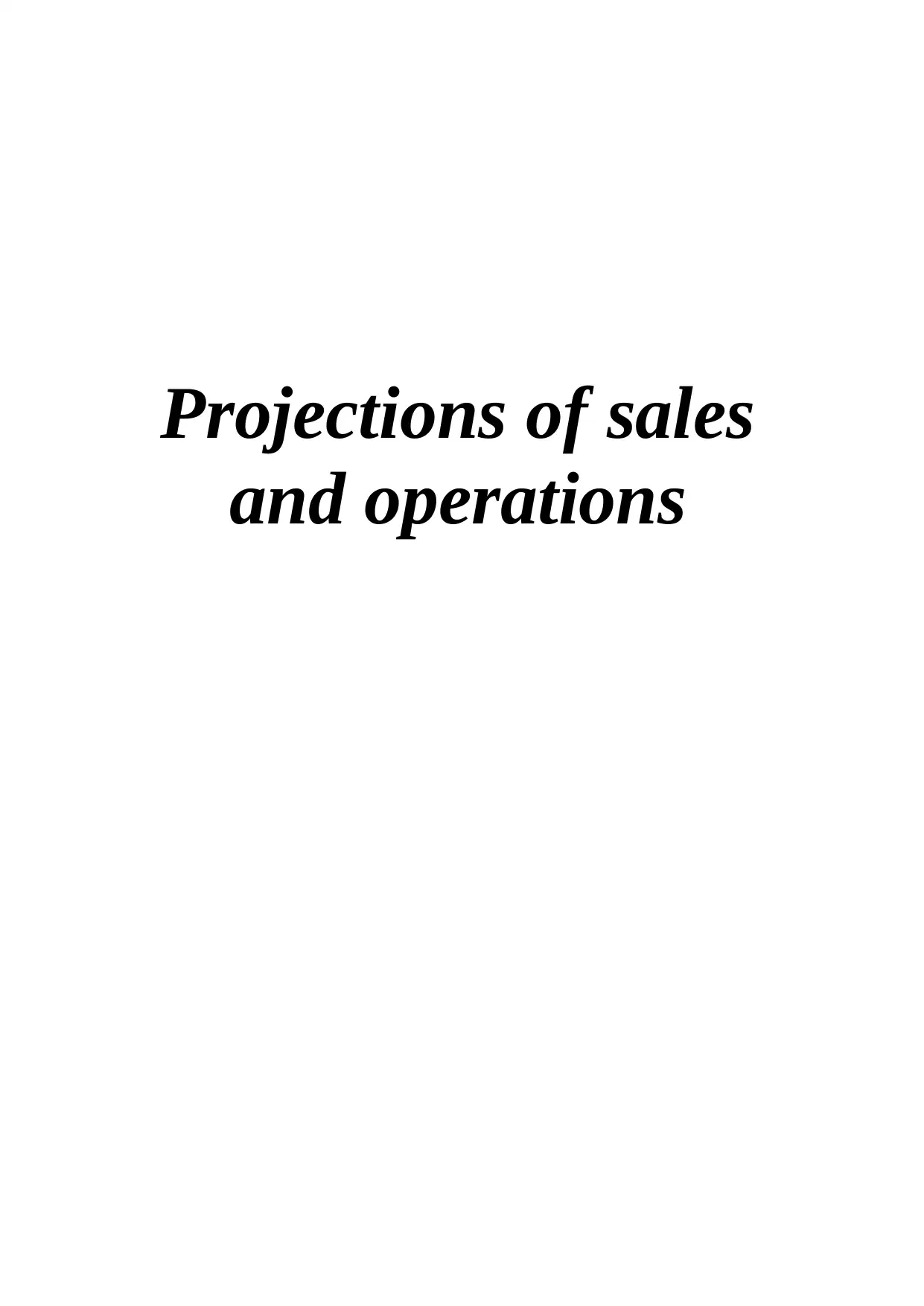
Projections of sales
and operations
and operations
Paraphrase This Document
Need a fresh take? Get an instant paraphrase of this document with our AI Paraphraser
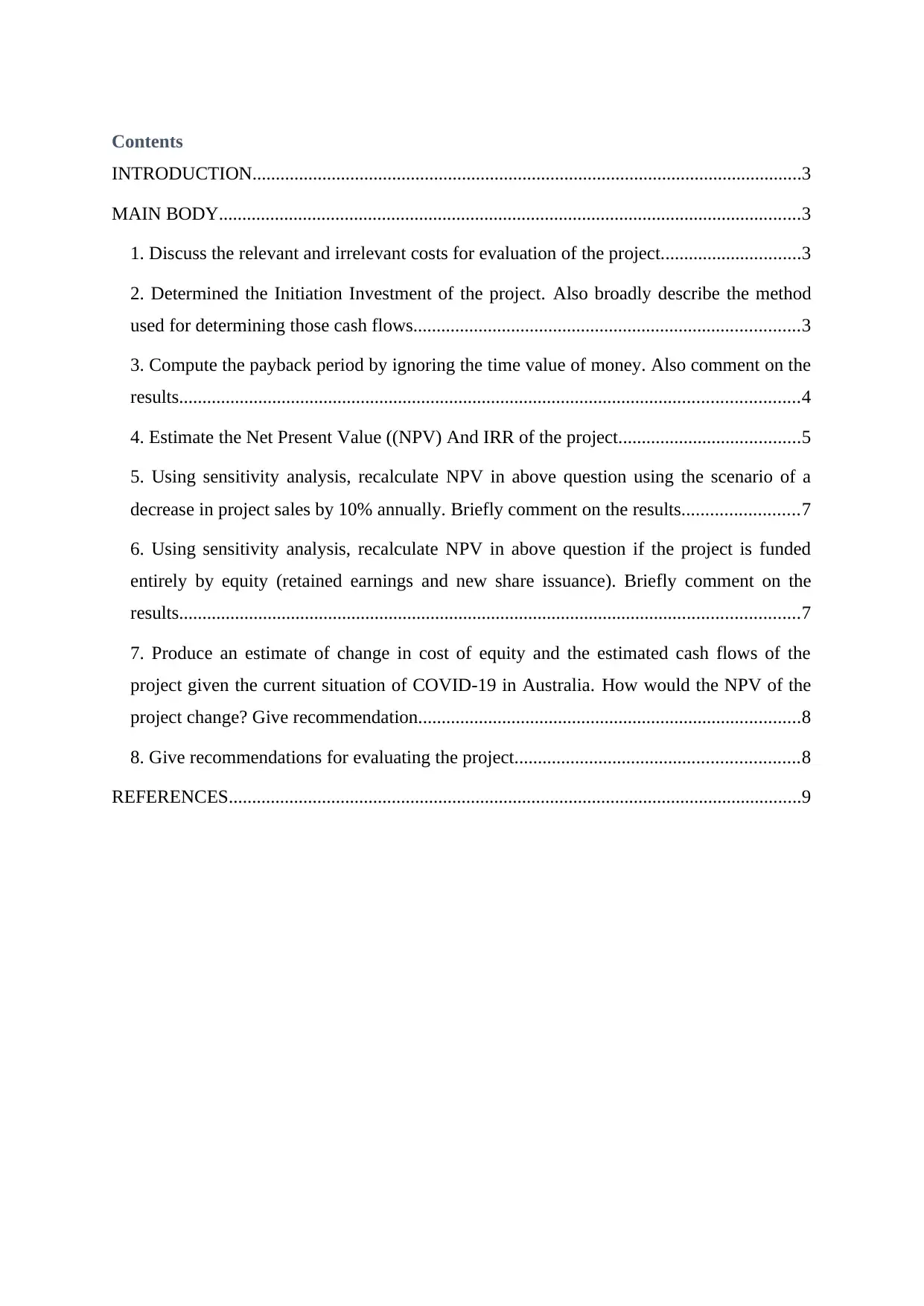
Contents
INTRODUCTION......................................................................................................................3
MAIN BODY.............................................................................................................................3
1. Discuss the relevant and irrelevant costs for evaluation of the project..............................3
2. Determined the Initiation Investment of the project. Also broadly describe the method
used for determining those cash flows...................................................................................3
3. Compute the payback period by ignoring the time value of money. Also comment on the
results.....................................................................................................................................4
4. Estimate the Net Present Value ((NPV) And IRR of the project.......................................5
5. Using sensitivity analysis, recalculate NPV in above question using the scenario of a
decrease in project sales by 10% annually. Briefly comment on the results.........................7
6. Using sensitivity analysis, recalculate NPV in above question if the project is funded
entirely by equity (retained earnings and new share issuance). Briefly comment on the
results.....................................................................................................................................7
7. Produce an estimate of change in cost of equity and the estimated cash flows of the
project given the current situation of COVID-19 in Australia. How would the NPV of the
project change? Give recommendation..................................................................................8
8. Give recommendations for evaluating the project.............................................................8
REFERENCES...........................................................................................................................9
INTRODUCTION......................................................................................................................3
MAIN BODY.............................................................................................................................3
1. Discuss the relevant and irrelevant costs for evaluation of the project..............................3
2. Determined the Initiation Investment of the project. Also broadly describe the method
used for determining those cash flows...................................................................................3
3. Compute the payback period by ignoring the time value of money. Also comment on the
results.....................................................................................................................................4
4. Estimate the Net Present Value ((NPV) And IRR of the project.......................................5
5. Using sensitivity analysis, recalculate NPV in above question using the scenario of a
decrease in project sales by 10% annually. Briefly comment on the results.........................7
6. Using sensitivity analysis, recalculate NPV in above question if the project is funded
entirely by equity (retained earnings and new share issuance). Briefly comment on the
results.....................................................................................................................................7
7. Produce an estimate of change in cost of equity and the estimated cash flows of the
project given the current situation of COVID-19 in Australia. How would the NPV of the
project change? Give recommendation..................................................................................8
8. Give recommendations for evaluating the project.............................................................8
REFERENCES...........................................................................................................................9
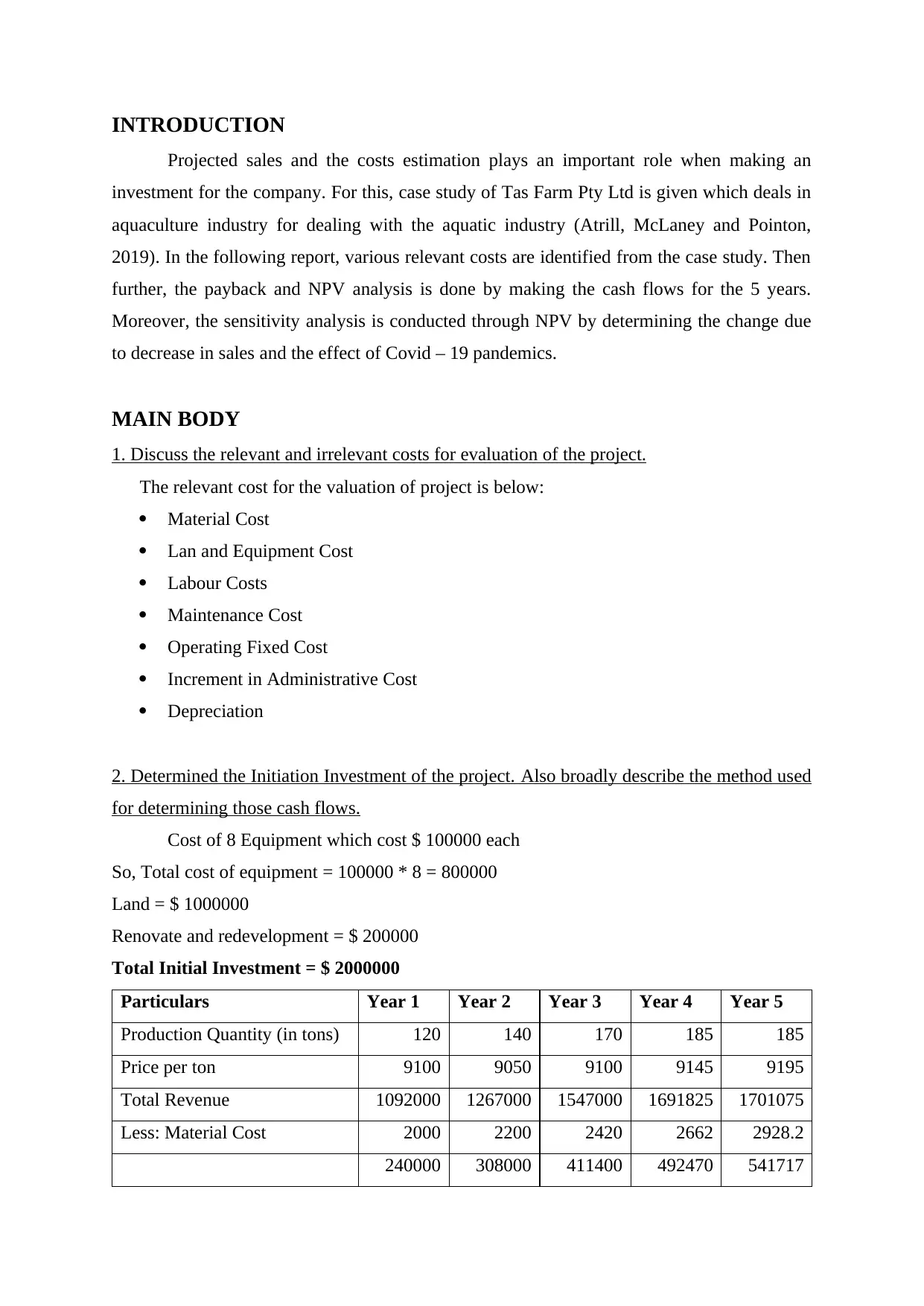
INTRODUCTION
Projected sales and the costs estimation plays an important role when making an
investment for the company. For this, case study of Tas Farm Pty Ltd is given which deals in
aquaculture industry for dealing with the aquatic industry (Atrill, McLaney and Pointon,
2019). In the following report, various relevant costs are identified from the case study. Then
further, the payback and NPV analysis is done by making the cash flows for the 5 years.
Moreover, the sensitivity analysis is conducted through NPV by determining the change due
to decrease in sales and the effect of Covid – 19 pandemics.
MAIN BODY
1. Discuss the relevant and irrelevant costs for evaluation of the project.
The relevant cost for the valuation of project is below:
Material Cost
Lan and Equipment Cost
Labour Costs
Maintenance Cost
Operating Fixed Cost
Increment in Administrative Cost
Depreciation
2. Determined the Initiation Investment of the project. Also broadly describe the method used
for determining those cash flows.
Cost of 8 Equipment which cost $ 100000 each
So, Total cost of equipment = 100000 * 8 = 800000
Land = $ 1000000
Renovate and redevelopment = $ 200000
Total Initial Investment = $ 2000000
Particulars Year 1 Year 2 Year 3 Year 4 Year 5
Production Quantity (in tons) 120 140 170 185 185
Price per ton 9100 9050 9100 9145 9195
Total Revenue 1092000 1267000 1547000 1691825 1701075
Less: Material Cost 2000 2200 2420 2662 2928.2
240000 308000 411400 492470 541717
Projected sales and the costs estimation plays an important role when making an
investment for the company. For this, case study of Tas Farm Pty Ltd is given which deals in
aquaculture industry for dealing with the aquatic industry (Atrill, McLaney and Pointon,
2019). In the following report, various relevant costs are identified from the case study. Then
further, the payback and NPV analysis is done by making the cash flows for the 5 years.
Moreover, the sensitivity analysis is conducted through NPV by determining the change due
to decrease in sales and the effect of Covid – 19 pandemics.
MAIN BODY
1. Discuss the relevant and irrelevant costs for evaluation of the project.
The relevant cost for the valuation of project is below:
Material Cost
Lan and Equipment Cost
Labour Costs
Maintenance Cost
Operating Fixed Cost
Increment in Administrative Cost
Depreciation
2. Determined the Initiation Investment of the project. Also broadly describe the method used
for determining those cash flows.
Cost of 8 Equipment which cost $ 100000 each
So, Total cost of equipment = 100000 * 8 = 800000
Land = $ 1000000
Renovate and redevelopment = $ 200000
Total Initial Investment = $ 2000000
Particulars Year 1 Year 2 Year 3 Year 4 Year 5
Production Quantity (in tons) 120 140 170 185 185
Price per ton 9100 9050 9100 9145 9195
Total Revenue 1092000 1267000 1547000 1691825 1701075
Less: Material Cost 2000 2200 2420 2662 2928.2
240000 308000 411400 492470 541717
⊘ This is a preview!⊘
Do you want full access?
Subscribe today to unlock all pages.

Trusted by 1+ million students worldwide
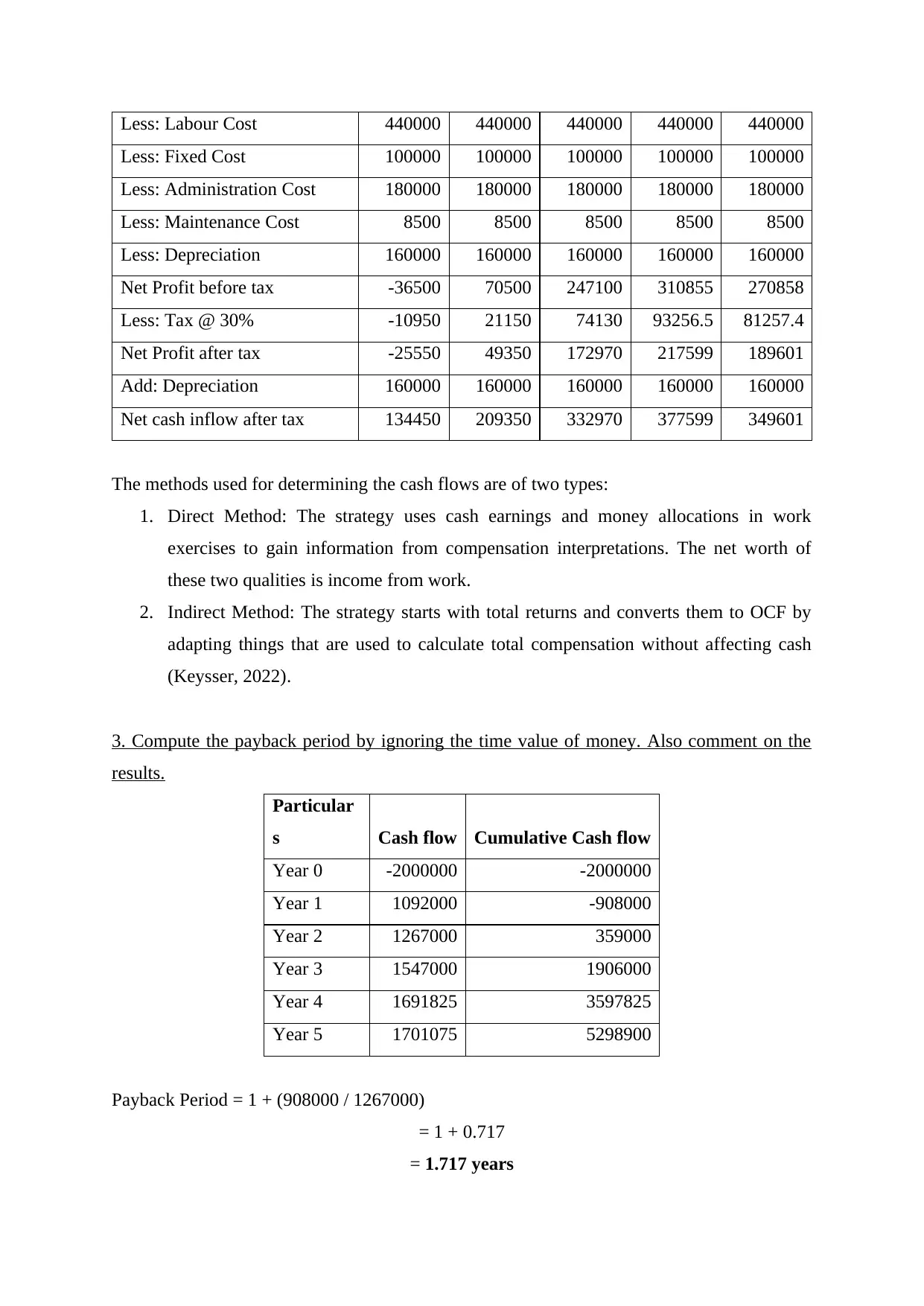
Less: Labour Cost 440000 440000 440000 440000 440000
Less: Fixed Cost 100000 100000 100000 100000 100000
Less: Administration Cost 180000 180000 180000 180000 180000
Less: Maintenance Cost 8500 8500 8500 8500 8500
Less: Depreciation 160000 160000 160000 160000 160000
Net Profit before tax -36500 70500 247100 310855 270858
Less: Tax @ 30% -10950 21150 74130 93256.5 81257.4
Net Profit after tax -25550 49350 172970 217599 189601
Add: Depreciation 160000 160000 160000 160000 160000
Net cash inflow after tax 134450 209350 332970 377599 349601
The methods used for determining the cash flows are of two types:
1. Direct Method: The strategy uses cash earnings and money allocations in work
exercises to gain information from compensation interpretations. The net worth of
these two qualities is income from work.
2. Indirect Method: The strategy starts with total returns and converts them to OCF by
adapting things that are used to calculate total compensation without affecting cash
(Keysser, 2022).
3. Compute the payback period by ignoring the time value of money. Also comment on the
results.
Particular
s Cash flow Cumulative Cash flow
Year 0 -2000000 -2000000
Year 1 1092000 -908000
Year 2 1267000 359000
Year 3 1547000 1906000
Year 4 1691825 3597825
Year 5 1701075 5298900
Payback Period = 1 + (908000 / 1267000)
= 1 + 0.717
= 1.717 years
Less: Fixed Cost 100000 100000 100000 100000 100000
Less: Administration Cost 180000 180000 180000 180000 180000
Less: Maintenance Cost 8500 8500 8500 8500 8500
Less: Depreciation 160000 160000 160000 160000 160000
Net Profit before tax -36500 70500 247100 310855 270858
Less: Tax @ 30% -10950 21150 74130 93256.5 81257.4
Net Profit after tax -25550 49350 172970 217599 189601
Add: Depreciation 160000 160000 160000 160000 160000
Net cash inflow after tax 134450 209350 332970 377599 349601
The methods used for determining the cash flows are of two types:
1. Direct Method: The strategy uses cash earnings and money allocations in work
exercises to gain information from compensation interpretations. The net worth of
these two qualities is income from work.
2. Indirect Method: The strategy starts with total returns and converts them to OCF by
adapting things that are used to calculate total compensation without affecting cash
(Keysser, 2022).
3. Compute the payback period by ignoring the time value of money. Also comment on the
results.
Particular
s Cash flow Cumulative Cash flow
Year 0 -2000000 -2000000
Year 1 1092000 -908000
Year 2 1267000 359000
Year 3 1547000 1906000
Year 4 1691825 3597825
Year 5 1701075 5298900
Payback Period = 1 + (908000 / 1267000)
= 1 + 0.717
= 1.717 years
Paraphrase This Document
Need a fresh take? Get an instant paraphrase of this document with our AI Paraphraser

The payback period is calculated for knowing the time of the return of the investment.
It simply means the time period in which the initial investment amount would be recouped
(Kondoh and et.al., 2018). From the above table and calculation of payback period, the initial
investment will be recouped in 1.717 years means 1 year and 8 months approximately.
4. Estimate the Net Present Value ((NPV) And IRR of the project.
Computation of Cost of Capital
Cost of Equity = Risk free rate of return + Beta (Market rate of return - risk free rate of
return)
= 3% + 1.2* (12% - 3%)
= 3% + 1.2 * 9%
=3% +10.8 = 13.8%
Particulars Year 1 Year 2 Year 3 Year 4 Year 5
Production Quantity (in tons) 120 140 170 185 185
Price per ton 9100 9050 9100 9145 9195
Total Revenue 1092000 1267000 1547000 1691825 1701075
Less: Material Cost 2000 2200 2420 2662 2928.2
240000 308000 411400 492470 541717
Less: Labour Cost 440000 440000 440000 440000 440000
Less: Fixed Cost 100000 100000 100000 100000 100000
Less: Administration Cost 180000 180000 180000 180000 180000
Less: Maintenance Cost 8500 8500 8500 8500 8500
Less: Depreciation 160000 160000 160000 160000 160000
Net Profit before tax -36500 70500 247100 310855 270858
Less: Tax @ 30% -10950 21150 74130 93256.5 81257.4
Net Profit after tax -25550 49350 172970 217598.5 189600.6
Add: Depreciation 160000 160000 160000 160000 160000
Net cash inflow after tax 134450 209350 332970 377598.5 349600.6
PV factor @ 13.8% 0.879 0.772 0.679 0.596 0.524
PV of Cash Inflows 118181.55 161618.2 226086.6 225048.7 183190.7
Total PV of Cash Inflows 914125.8
Less: Initial Investment 2000000
Net Present Value -1085874.2
It simply means the time period in which the initial investment amount would be recouped
(Kondoh and et.al., 2018). From the above table and calculation of payback period, the initial
investment will be recouped in 1.717 years means 1 year and 8 months approximately.
4. Estimate the Net Present Value ((NPV) And IRR of the project.
Computation of Cost of Capital
Cost of Equity = Risk free rate of return + Beta (Market rate of return - risk free rate of
return)
= 3% + 1.2* (12% - 3%)
= 3% + 1.2 * 9%
=3% +10.8 = 13.8%
Particulars Year 1 Year 2 Year 3 Year 4 Year 5
Production Quantity (in tons) 120 140 170 185 185
Price per ton 9100 9050 9100 9145 9195
Total Revenue 1092000 1267000 1547000 1691825 1701075
Less: Material Cost 2000 2200 2420 2662 2928.2
240000 308000 411400 492470 541717
Less: Labour Cost 440000 440000 440000 440000 440000
Less: Fixed Cost 100000 100000 100000 100000 100000
Less: Administration Cost 180000 180000 180000 180000 180000
Less: Maintenance Cost 8500 8500 8500 8500 8500
Less: Depreciation 160000 160000 160000 160000 160000
Net Profit before tax -36500 70500 247100 310855 270858
Less: Tax @ 30% -10950 21150 74130 93256.5 81257.4
Net Profit after tax -25550 49350 172970 217598.5 189600.6
Add: Depreciation 160000 160000 160000 160000 160000
Net cash inflow after tax 134450 209350 332970 377598.5 349600.6
PV factor @ 13.8% 0.879 0.772 0.679 0.596 0.524
PV of Cash Inflows 118181.55 161618.2 226086.6 225048.7 183190.7
Total PV of Cash Inflows 914125.8
Less: Initial Investment 2000000
Net Present Value -1085874.2
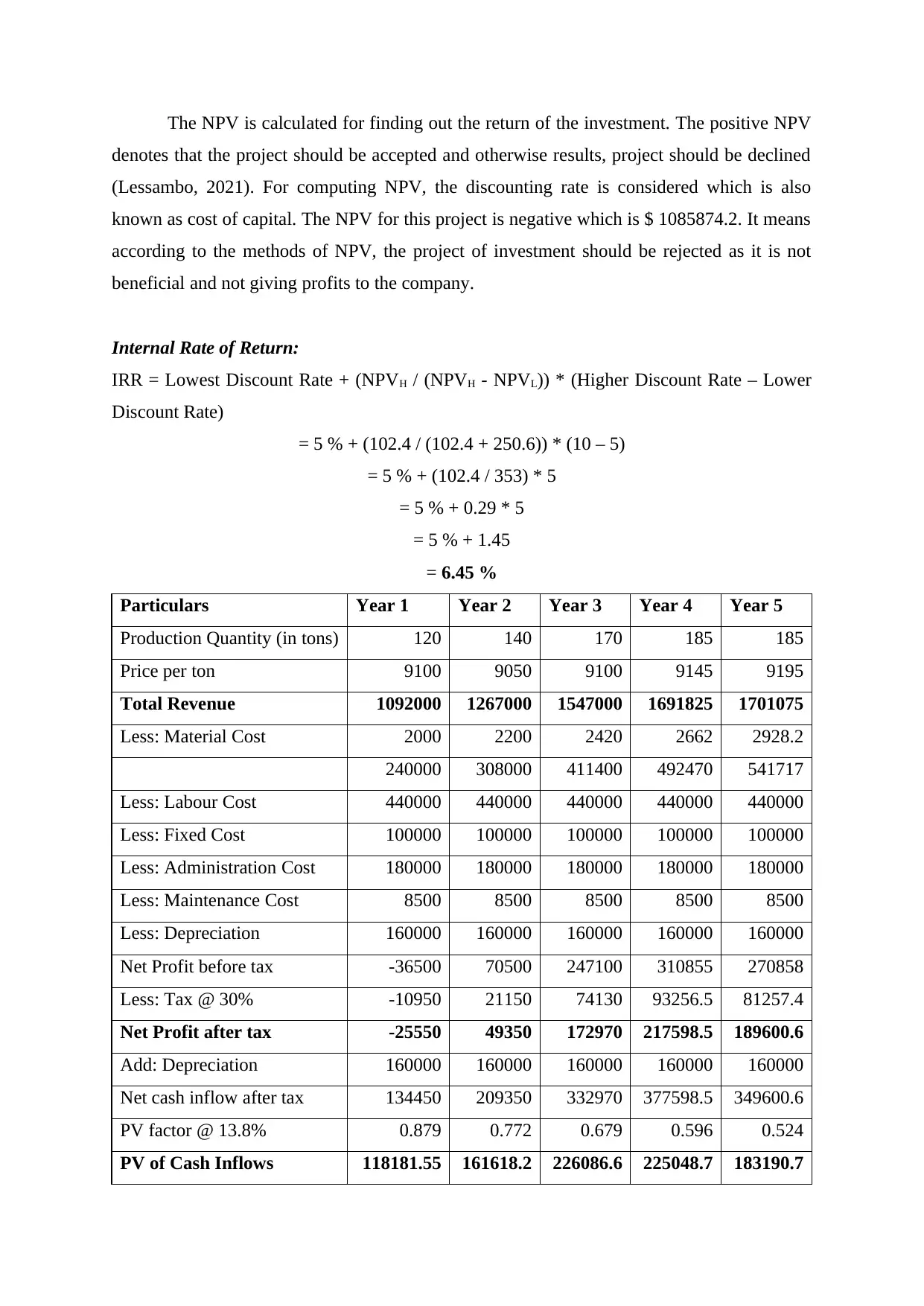
The NPV is calculated for finding out the return of the investment. The positive NPV
denotes that the project should be accepted and otherwise results, project should be declined
(Lessambo, 2021). For computing NPV, the discounting rate is considered which is also
known as cost of capital. The NPV for this project is negative which is $ 1085874.2. It means
according to the methods of NPV, the project of investment should be rejected as it is not
beneficial and not giving profits to the company.
Internal Rate of Return:
IRR = Lowest Discount Rate + (NPVH / (NPVH - NPVL)) * (Higher Discount Rate – Lower
Discount Rate)
= 5 % + (102.4 / (102.4 + 250.6)) * (10 – 5)
= 5 % + (102.4 / 353) * 5
= 5 % + 0.29 * 5
= 5 % + 1.45
= 6.45 %
Particulars Year 1 Year 2 Year 3 Year 4 Year 5
Production Quantity (in tons) 120 140 170 185 185
Price per ton 9100 9050 9100 9145 9195
Total Revenue 1092000 1267000 1547000 1691825 1701075
Less: Material Cost 2000 2200 2420 2662 2928.2
240000 308000 411400 492470 541717
Less: Labour Cost 440000 440000 440000 440000 440000
Less: Fixed Cost 100000 100000 100000 100000 100000
Less: Administration Cost 180000 180000 180000 180000 180000
Less: Maintenance Cost 8500 8500 8500 8500 8500
Less: Depreciation 160000 160000 160000 160000 160000
Net Profit before tax -36500 70500 247100 310855 270858
Less: Tax @ 30% -10950 21150 74130 93256.5 81257.4
Net Profit after tax -25550 49350 172970 217598.5 189600.6
Add: Depreciation 160000 160000 160000 160000 160000
Net cash inflow after tax 134450 209350 332970 377598.5 349600.6
PV factor @ 13.8% 0.879 0.772 0.679 0.596 0.524
PV of Cash Inflows 118181.55 161618.2 226086.6 225048.7 183190.7
denotes that the project should be accepted and otherwise results, project should be declined
(Lessambo, 2021). For computing NPV, the discounting rate is considered which is also
known as cost of capital. The NPV for this project is negative which is $ 1085874.2. It means
according to the methods of NPV, the project of investment should be rejected as it is not
beneficial and not giving profits to the company.
Internal Rate of Return:
IRR = Lowest Discount Rate + (NPVH / (NPVH - NPVL)) * (Higher Discount Rate – Lower
Discount Rate)
= 5 % + (102.4 / (102.4 + 250.6)) * (10 – 5)
= 5 % + (102.4 / 353) * 5
= 5 % + 0.29 * 5
= 5 % + 1.45
= 6.45 %
Particulars Year 1 Year 2 Year 3 Year 4 Year 5
Production Quantity (in tons) 120 140 170 185 185
Price per ton 9100 9050 9100 9145 9195
Total Revenue 1092000 1267000 1547000 1691825 1701075
Less: Material Cost 2000 2200 2420 2662 2928.2
240000 308000 411400 492470 541717
Less: Labour Cost 440000 440000 440000 440000 440000
Less: Fixed Cost 100000 100000 100000 100000 100000
Less: Administration Cost 180000 180000 180000 180000 180000
Less: Maintenance Cost 8500 8500 8500 8500 8500
Less: Depreciation 160000 160000 160000 160000 160000
Net Profit before tax -36500 70500 247100 310855 270858
Less: Tax @ 30% -10950 21150 74130 93256.5 81257.4
Net Profit after tax -25550 49350 172970 217598.5 189600.6
Add: Depreciation 160000 160000 160000 160000 160000
Net cash inflow after tax 134450 209350 332970 377598.5 349600.6
PV factor @ 13.8% 0.879 0.772 0.679 0.596 0.524
PV of Cash Inflows 118181.55 161618.2 226086.6 225048.7 183190.7
⊘ This is a preview!⊘
Do you want full access?
Subscribe today to unlock all pages.

Trusted by 1+ million students worldwide
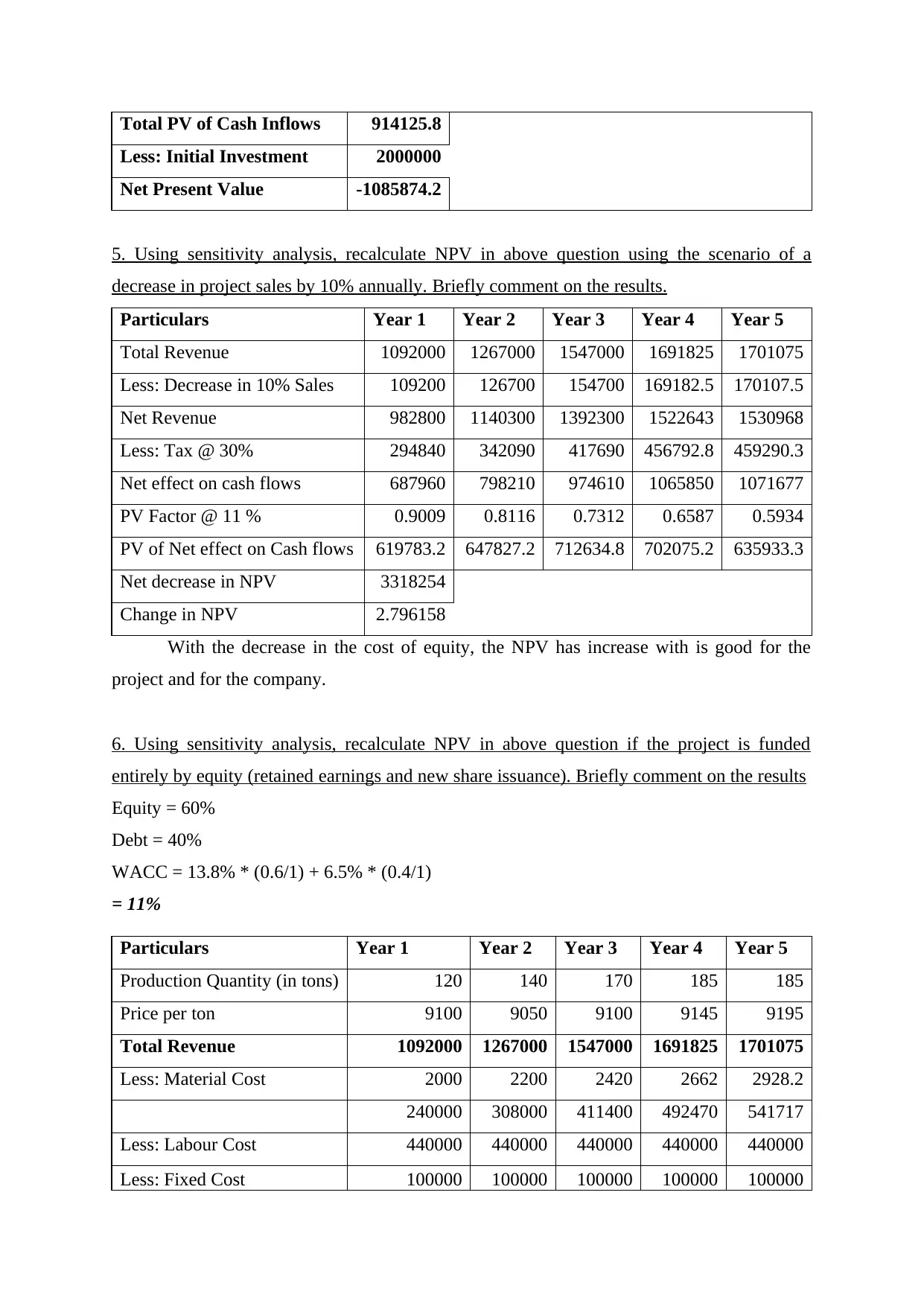
Total PV of Cash Inflows 914125.8
Less: Initial Investment 2000000
Net Present Value -1085874.2
5. Using sensitivity analysis, recalculate NPV in above question using the scenario of a
decrease in project sales by 10% annually. Briefly comment on the results.
Particulars Year 1 Year 2 Year 3 Year 4 Year 5
Total Revenue 1092000 1267000 1547000 1691825 1701075
Less: Decrease in 10% Sales 109200 126700 154700 169182.5 170107.5
Net Revenue 982800 1140300 1392300 1522643 1530968
Less: Tax @ 30% 294840 342090 417690 456792.8 459290.3
Net effect on cash flows 687960 798210 974610 1065850 1071677
PV Factor @ 11 % 0.9009 0.8116 0.7312 0.6587 0.5934
PV of Net effect on Cash flows 619783.2 647827.2 712634.8 702075.2 635933.3
Net decrease in NPV 3318254
Change in NPV 2.796158
With the decrease in the cost of equity, the NPV has increase with is good for the
project and for the company.
6. Using sensitivity analysis, recalculate NPV in above question if the project is funded
entirely by equity (retained earnings and new share issuance). Briefly comment on the results
Equity = 60%
Debt = 40%
WACC = 13.8% * (0.6/1) + 6.5% * (0.4/1)
= 11%
Particulars Year 1 Year 2 Year 3 Year 4 Year 5
Production Quantity (in tons) 120 140 170 185 185
Price per ton 9100 9050 9100 9145 9195
Total Revenue 1092000 1267000 1547000 1691825 1701075
Less: Material Cost 2000 2200 2420 2662 2928.2
240000 308000 411400 492470 541717
Less: Labour Cost 440000 440000 440000 440000 440000
Less: Fixed Cost 100000 100000 100000 100000 100000
Less: Initial Investment 2000000
Net Present Value -1085874.2
5. Using sensitivity analysis, recalculate NPV in above question using the scenario of a
decrease in project sales by 10% annually. Briefly comment on the results.
Particulars Year 1 Year 2 Year 3 Year 4 Year 5
Total Revenue 1092000 1267000 1547000 1691825 1701075
Less: Decrease in 10% Sales 109200 126700 154700 169182.5 170107.5
Net Revenue 982800 1140300 1392300 1522643 1530968
Less: Tax @ 30% 294840 342090 417690 456792.8 459290.3
Net effect on cash flows 687960 798210 974610 1065850 1071677
PV Factor @ 11 % 0.9009 0.8116 0.7312 0.6587 0.5934
PV of Net effect on Cash flows 619783.2 647827.2 712634.8 702075.2 635933.3
Net decrease in NPV 3318254
Change in NPV 2.796158
With the decrease in the cost of equity, the NPV has increase with is good for the
project and for the company.
6. Using sensitivity analysis, recalculate NPV in above question if the project is funded
entirely by equity (retained earnings and new share issuance). Briefly comment on the results
Equity = 60%
Debt = 40%
WACC = 13.8% * (0.6/1) + 6.5% * (0.4/1)
= 11%
Particulars Year 1 Year 2 Year 3 Year 4 Year 5
Production Quantity (in tons) 120 140 170 185 185
Price per ton 9100 9050 9100 9145 9195
Total Revenue 1092000 1267000 1547000 1691825 1701075
Less: Material Cost 2000 2200 2420 2662 2928.2
240000 308000 411400 492470 541717
Less: Labour Cost 440000 440000 440000 440000 440000
Less: Fixed Cost 100000 100000 100000 100000 100000
Paraphrase This Document
Need a fresh take? Get an instant paraphrase of this document with our AI Paraphraser
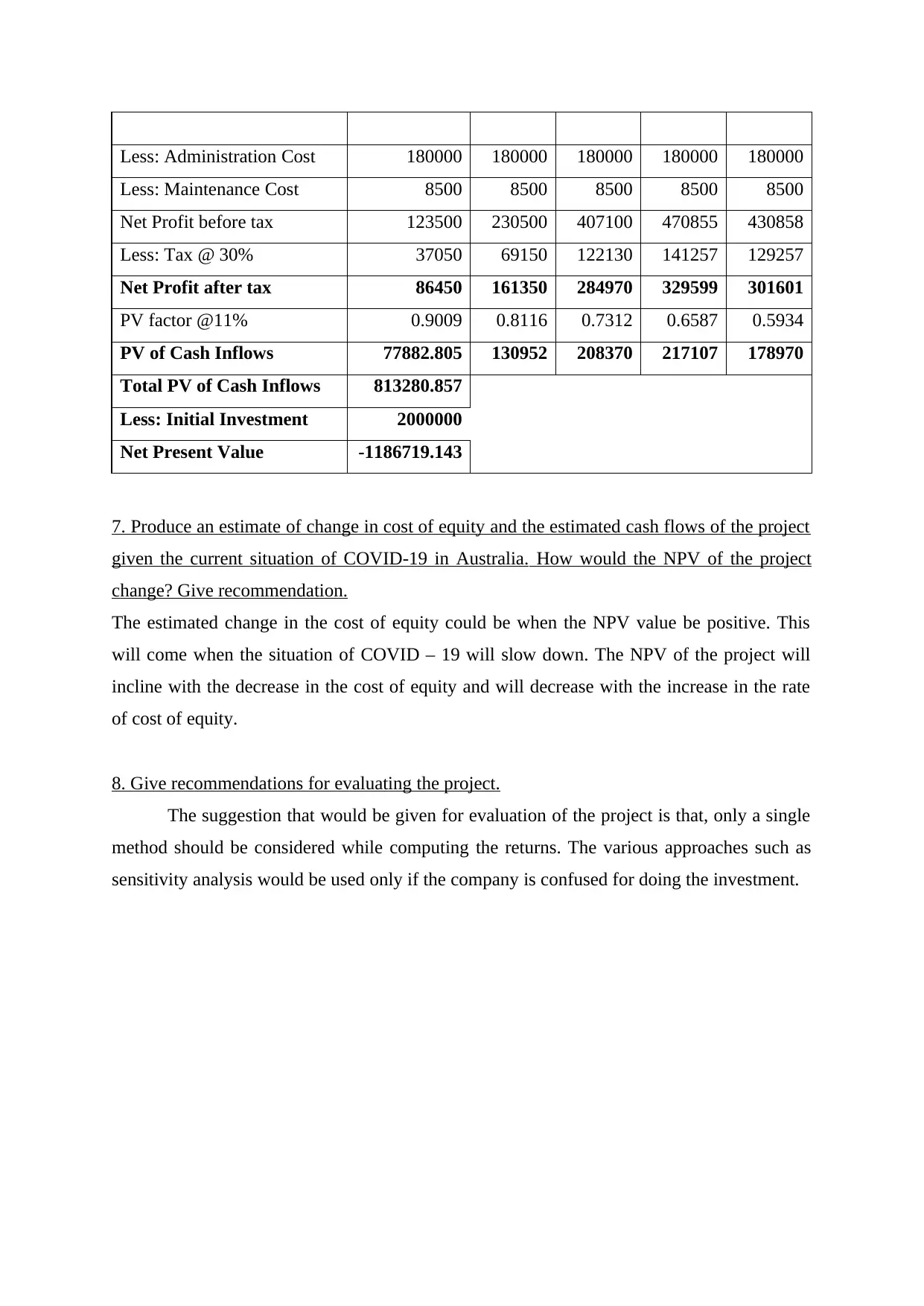
Less: Administration Cost 180000 180000 180000 180000 180000
Less: Maintenance Cost 8500 8500 8500 8500 8500
Net Profit before tax 123500 230500 407100 470855 430858
Less: Tax @ 30% 37050 69150 122130 141257 129257
Net Profit after tax 86450 161350 284970 329599 301601
PV factor @11% 0.9009 0.8116 0.7312 0.6587 0.5934
PV of Cash Inflows 77882.805 130952 208370 217107 178970
Total PV of Cash Inflows 813280.857
Less: Initial Investment 2000000
Net Present Value -1186719.143
7. Produce an estimate of change in cost of equity and the estimated cash flows of the project
given the current situation of COVID-19 in Australia. How would the NPV of the project
change? Give recommendation.
The estimated change in the cost of equity could be when the NPV value be positive. This
will come when the situation of COVID – 19 will slow down. The NPV of the project will
incline with the decrease in the cost of equity and will decrease with the increase in the rate
of cost of equity.
8. Give recommendations for evaluating the project.
The suggestion that would be given for evaluation of the project is that, only a single
method should be considered while computing the returns. The various approaches such as
sensitivity analysis would be used only if the company is confused for doing the investment.
Less: Maintenance Cost 8500 8500 8500 8500 8500
Net Profit before tax 123500 230500 407100 470855 430858
Less: Tax @ 30% 37050 69150 122130 141257 129257
Net Profit after tax 86450 161350 284970 329599 301601
PV factor @11% 0.9009 0.8116 0.7312 0.6587 0.5934
PV of Cash Inflows 77882.805 130952 208370 217107 178970
Total PV of Cash Inflows 813280.857
Less: Initial Investment 2000000
Net Present Value -1186719.143
7. Produce an estimate of change in cost of equity and the estimated cash flows of the project
given the current situation of COVID-19 in Australia. How would the NPV of the project
change? Give recommendation.
The estimated change in the cost of equity could be when the NPV value be positive. This
will come when the situation of COVID – 19 will slow down. The NPV of the project will
incline with the decrease in the cost of equity and will decrease with the increase in the rate
of cost of equity.
8. Give recommendations for evaluating the project.
The suggestion that would be given for evaluation of the project is that, only a single
method should be considered while computing the returns. The various approaches such as
sensitivity analysis would be used only if the company is confused for doing the investment.
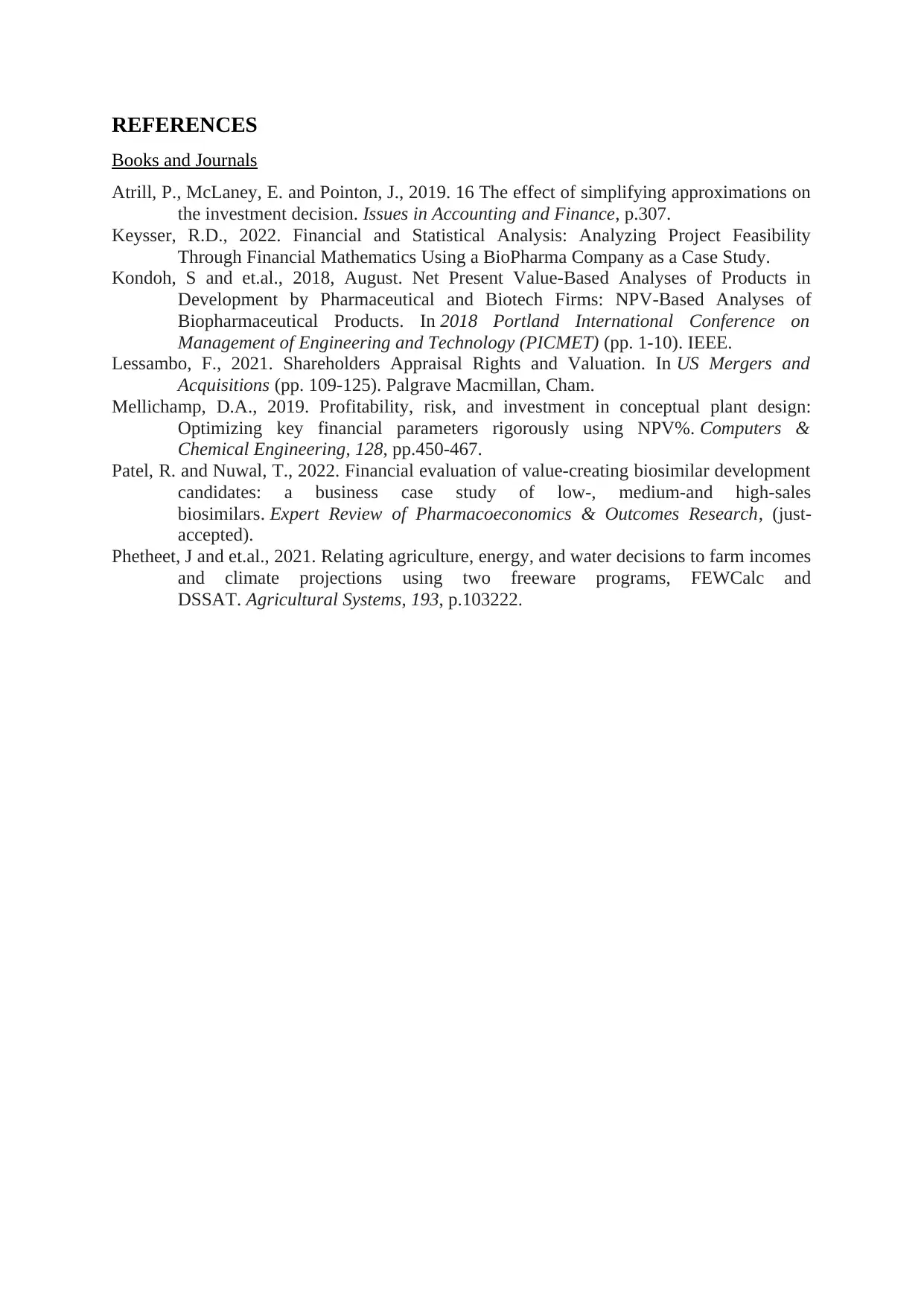
REFERENCES
Books and Journals
Atrill, P., McLaney, E. and Pointon, J., 2019. 16 The effect of simplifying approximations on
the investment decision. Issues in Accounting and Finance, p.307.
Keysser, R.D., 2022. Financial and Statistical Analysis: Analyzing Project Feasibility
Through Financial Mathematics Using a BioPharma Company as a Case Study.
Kondoh, S and et.al., 2018, August. Net Present Value-Based Analyses of Products in
Development by Pharmaceutical and Biotech Firms: NPV-Based Analyses of
Biopharmaceutical Products. In 2018 Portland International Conference on
Management of Engineering and Technology (PICMET) (pp. 1-10). IEEE.
Lessambo, F., 2021. Shareholders Appraisal Rights and Valuation. In US Mergers and
Acquisitions (pp. 109-125). Palgrave Macmillan, Cham.
Mellichamp, D.A., 2019. Profitability, risk, and investment in conceptual plant design:
Optimizing key financial parameters rigorously using NPV%. Computers &
Chemical Engineering, 128, pp.450-467.
Patel, R. and Nuwal, T., 2022. Financial evaluation of value-creating biosimilar development
candidates: a business case study of low-, medium-and high-sales
biosimilars. Expert Review of Pharmacoeconomics & Outcomes Research, (just-
accepted).
Phetheet, J and et.al., 2021. Relating agriculture, energy, and water decisions to farm incomes
and climate projections using two freeware programs, FEWCalc and
DSSAT. Agricultural Systems, 193, p.103222.
Books and Journals
Atrill, P., McLaney, E. and Pointon, J., 2019. 16 The effect of simplifying approximations on
the investment decision. Issues in Accounting and Finance, p.307.
Keysser, R.D., 2022. Financial and Statistical Analysis: Analyzing Project Feasibility
Through Financial Mathematics Using a BioPharma Company as a Case Study.
Kondoh, S and et.al., 2018, August. Net Present Value-Based Analyses of Products in
Development by Pharmaceutical and Biotech Firms: NPV-Based Analyses of
Biopharmaceutical Products. In 2018 Portland International Conference on
Management of Engineering and Technology (PICMET) (pp. 1-10). IEEE.
Lessambo, F., 2021. Shareholders Appraisal Rights and Valuation. In US Mergers and
Acquisitions (pp. 109-125). Palgrave Macmillan, Cham.
Mellichamp, D.A., 2019. Profitability, risk, and investment in conceptual plant design:
Optimizing key financial parameters rigorously using NPV%. Computers &
Chemical Engineering, 128, pp.450-467.
Patel, R. and Nuwal, T., 2022. Financial evaluation of value-creating biosimilar development
candidates: a business case study of low-, medium-and high-sales
biosimilars. Expert Review of Pharmacoeconomics & Outcomes Research, (just-
accepted).
Phetheet, J and et.al., 2021. Relating agriculture, energy, and water decisions to farm incomes
and climate projections using two freeware programs, FEWCalc and
DSSAT. Agricultural Systems, 193, p.103222.
⊘ This is a preview!⊘
Do you want full access?
Subscribe today to unlock all pages.

Trusted by 1+ million students worldwide
1 out of 9